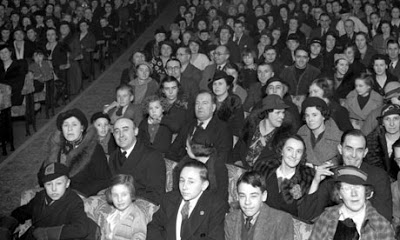As the movies sought to become a more “respectable” art, with associations with legitimate theater, the cinema as a screening venue became a more formal and less interactive place. While talking, singing, joking and so on were a common part of the early filmgoing experience, theater owners sought to enforce “proper” audience behavior as films themselves became longer and more of an “event”. While early audiences would have seen movies in fairgrounds or on music hall and vaudeville programs, by 1915 or so, huge “picture palaces” began appearing as more fitting venues for major motion pictures of the day, such as THE BIRTH OF A NATION and INTOLERANCE, which D.W. Griffith intended to provide an entire evening’s entertainment. This is more or less the same audience protocol that we’ve come to expect at the movies.
Movies are still an “experience”, with increasingly elaborate technological ploys designed to bring audiences in to theaters and away from their television sets, computers, iPhones, and other devices through which we now receive content. This, of course, is the oldest strategy in the book – even the latest fad for 3D has seen previous attempts to market the process to audiences, in the 1950s (in response to losing audiences to television), and in the early 1980s (in response to the rise of consumer use of videotapes as a substitute for the theatrical experience).
Now, with more options than ever, films need to be “bigger and better” than ever to attract audiences to opening weekend screenings and to justify the cost of the ticket to see a theatrical screening.
Tempting as it is to extol the advantages of consuming media on these new devices (and there certainly are many benefits to it!), there is something to be said for the communal experience of the movie house screening.
I can think of many films that I am already well familiar with which have really “come to life” when viewed with an audience. Comedies, in particular, are essential to view with a group, particularly those made during comedy’s golden age in the silent period. The comedies of geniuses like Keaton, Lloyd, Fields and the Marx Bros. are best appreciated with a large audience who really “get” the jokes and laugh in all the right places; having this experience, one becomes aware of just how expertly timed these films are.
Even a more recent comedy, Stanley Kubrick’s DR. STRANGELOVE, produces gales of laughter when seen with an audience where it might only provide chuckles when viewed alone on a TV set. The horror film, in particular, is a genre that benefits from being seen with an audience.
Despite the idea that it might be more frightening watching such films alone, there’s nothing like that collective moment when the audience jumps in shock, or gasps in horror, and have a powerful shared experience. Such moments of horror – the discovery of Mrs. Bates in the cellar in PSYCHO, the discovery of the corpse at the top of the stair case in NIGHT OF THE LIVING DEAD – invariable lend themselves best to being shared with others, where the reaction of fear becomes practically tangible. Of course, this is closely related to the effect produced by an unexpectedly brilliant and funny gag in a comedy, where the shared response of the audience makes it all the more effective.
Despite the changing moviegoing experience, particularly over the last 15 years, the variety of programs included on early Nickelodeon bills is quite reminiscent of the variety of entertainment options now available through digital media. It’s easy to tune from a bit of a song, to a short online video, to a digital photo gallery, and so on, and experience all of these media within a very short span.
However, what the digital realm has yet to provide a solution to is that communal experience that is lost when not in the physical proximity of an audience. The interaction that is lost results in a different kind of viewing experience, one that can be equally rewarding, of course, but quite different from the shared experience of moviegoing as audiences have known it for close to a century.
Analysis:
The article emphasizes the communal experience among audiences, such as the shared laugh, gasp of horror, and shock, all of these reactions create the tangible effects of the movie. Therefore, communal experience enhances the movie experience.
For movie theaters’ development, it is essential to identify its advantage and recognize its value. The communal experience could be the core value and made movie theater different from streaming service. Also, during the pandemic, the physical proximity of people is stretched far, the interaction and communication might be the urgent demand in pandemic life. Although the protocol of moviegoing asks audiences not to disrupt others, we may find a proper way to let audiences interact and react.




